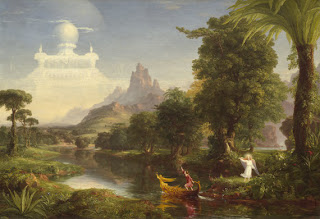 While a comic book is pretty easy to define based on what we've already discussed ("comics in magazine format," perhaps), the term "graphic novel" is thrown around quite a bit, and I feel it behooves us to clarify what exactly that means.
While a comic book is pretty easy to define based on what we've already discussed ("comics in magazine format," perhaps), the term "graphic novel" is thrown around quite a bit, and I feel it behooves us to clarify what exactly that means.A graphic novel generally has more to it than a comic book. For one thing, graphic novels have self-contained stories (beginning, middle, end) whereas a regular comic book usually has a story that's spread over several issues. Some argue that graphic novels generally deal with more mature themes and have a higher quality of art in the pages, though this is certainly debatable. Graphic novels may also be collections of several comic books into one volume.
Excellent examples of graphic novels include (but are certainly not limited to):
- Art Spiegelman's Maus, which reflects on the author's family involvement in the Holocaust, with the characters symbolically portrayed as animals.
- Kingdom Come by Mark Waid and Alex Ross, a collection of a "what if"-type miniseries by DC Comics, where the tale of a future Superman battling the misled ideals of a new generation of metahumans serves as a catalyst for themes of politics, responsibility, humility, empathy, and more -- on really deep levels. Ross's artwork is amazing in this book -- photorealistic paintings that create a very down-to-earth setting for the messages to thrive in.

- JLA: Earth 2 by Grant Morrison and Frank Quitely, like Maus, is not a collection of comic books, but reads and feels more like a straightforward, prestige-format comic book tale than Kingdom Come might. It reintroduces the concept of a multidimensional universe to the DC Comics heroes by pitting the Justice League up against their evil counterparts from another Earth.

Alan Moore, creator of the highly-acclaimed comic maxiseries The Watchmen (which is frequently referred to as a graphic novel in its collected format), had the following to say in reference to the surge of the term's usage in the '80s:
The problem is that "graphic novel" just came to mean "expensive comic book" and so what you'd get is people like DC Comics or Marvel comics - because "graphic novels" were getting some attention, they'd stick six issues of whatever worthless piece of crap they happened to be publishing lately under a glossy cover and call it "The She-Hulk Graphic Novel," you know? (full interview here)Those who aren't avid comic book readers may have found yourself being snootily corrected by a comic fan when you accused him of reading a "comic book" when he was, in fact, reading a "graphic novel." In these cases I would counsel you to brush it off and feel justified in your feeling that the guy needs to learn to relax. Given that the term is often used for marketing purposes, isn't officially recognized by all professionals as legit, and has a pretty vague definition, there's no reason to force everyone to upgrade their vocabulary just yet.
I think the comic fan who goes out of his way to correct others in such a way is getting defensive in order to justify to himself that he's not reading kiddie cartoons, that what he's looking at is geared towards a higher age group, and therefore he has a life. While this is certainly less effective in changing the world's views of comics, what does it say about me, the guy who decided to devote an entire blog to justifying his love of the medium? Oh, dear...
To wrap this up, the purpose of this post is to simply establish an understanding in the reader of what others mean when distinguishing between the two phrases, and to understand that there certainly ARE comics out there that read like novels and have varying degrees of depth, with artwork that stands out as masterpieces.








